
Latest News
- Hyundai E&C Shifts into High Gear to Enter Nordic Large-Scale Nuclear Market
- Hyundai E&C Strengthens Korea-Japan Cooperation in Energy Transition and New Growth Businesses
- Hyundai E&C Signals Green Light for Large-Scale Nuclear Power Plant Business in Europe
- Hyundai E&C Unveils Energy-driven Growth Strategy “H-Road”
- Hyundai E&C to Build First Unit of SMR-300, a Model for U.S.-Korea Energy Cooperation
Cities Skylines Gallery : Hyundai E&C’s High-Sky Journey
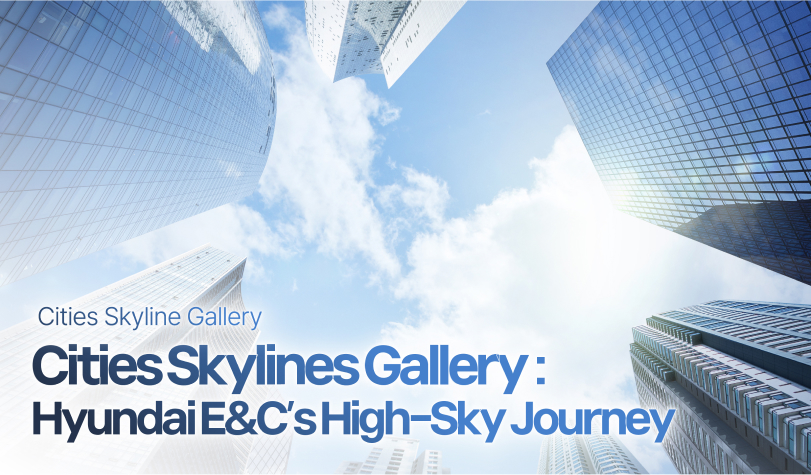
Skyscrapers reaching toward the sky naturally become prominent landmarks in any region. When looking up at the towering buildings constructed by Hyundai E&C, one will be captivated not just by their height but also by their sleek designs, infused with cutting-edge technology. Let's take a journey along Hyundai E&C's skyline and explore these wonderful landmarks together!
The Gigantic Soaring Wings of Qatar: Lusail Plaza Towers
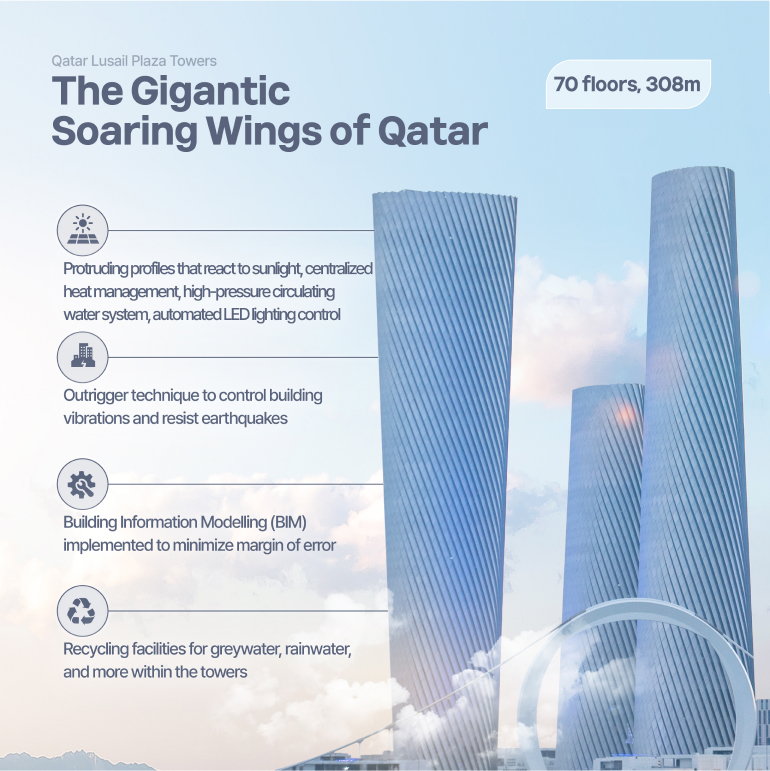
Qatar, the host country of the 2022 World Cup, is back in the spotlight in 2023 with a massive new complex near Lusail Stadium. At the heart of this development is Lusail Plaza Tower, featuring four buildings that reach up to 70 stories. Hyundai E&C constructed the two tallest towers, Plot 3 and Plot 4, standing at 70 stories and 308 meters each. These towering twin wings are nothing short of breathtaking.
The stunning exterior boasts a unique curved design that narrows and widens as it rises, making each floor different in size and adding significant complexity to the construction. To tackle these challenges, Hyundai E&C utilized Building Information Modelling (BIM) from the early design stages, creating a 3D model to minimize errors. Crucially, the company focused on ensuring the safety of the two towers, each standing over 300 meters tall, by reinforcing their ability to withstand strong winds. To further enhance wind resistance, the Korean builder conducted wind power and pressure tests on a 1/500 scale model in their own wind tunnel test lab, refining its expertise in wind-resistant design.
In addition to its towering and stunning façade, Lusail Plaza Towers is packed with cutting-edge Hyundai E&C technologies. The building's protruding profiles are designed to respond to sunlight, preserving outdoor views and natural light while providing shade to combat the intense desert heat. Energy efficiency is further enhanced through centralized thermal management, a high-pressure hydronic system, demand-controlled ventilation, and automated LED lighting control. With the exterior construction successfully completed, the focus has now shifted to finalizing the interior.
Standing Tall as a Landmark in Ho Chi Minh City, Vietnam: BITEXCO Financial Tower
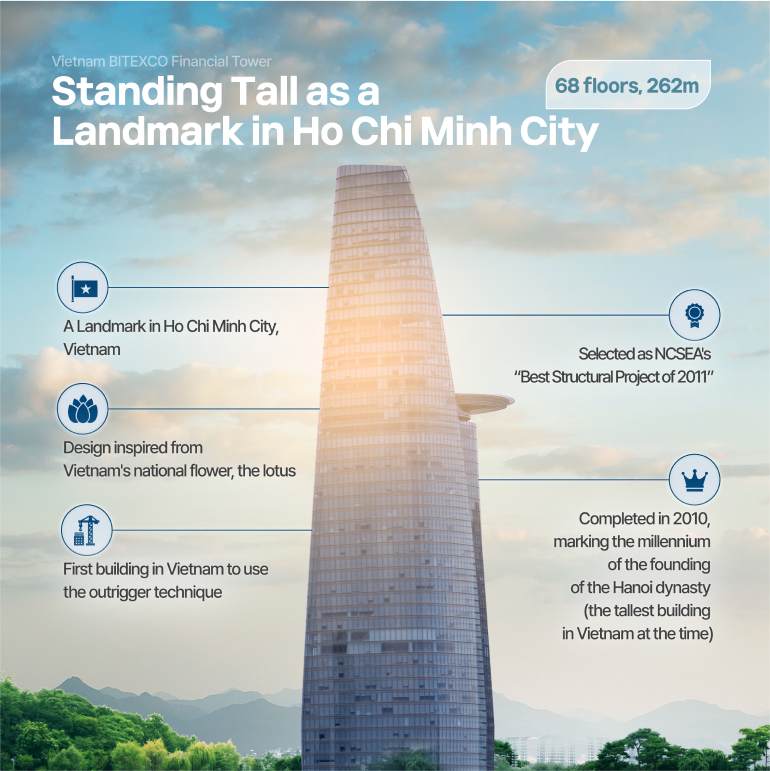
BITEXCO Financial Tower is an iconic building in Ho Chi Minh City, Vietnam's economic capital. The 68-story, 262-meter-high building is shaped like the peak of a lotus flower, the national flower of Vietnam, and has a unique shape that is convex up to the 24th floor and then narrows as it goes up. From the 38th to 50th floors, the building is in a twisted form, and the observation deck on the 47th floor offers 360-degree views of Ho Chi Minh City and the Saigon River. The building's artistic façade alone requires a very technical expertise, and it is the first building in Vietnam to be constructed with outriggers.

Bitexco Financial Tower project in Ho Chi Minh City faced the challenge of safely completing construction within a short timeframe, given the city's limited construction infrastructure. However, Hyundai E&C's exceptional technical expertise, combined with the dedication of the site staff, ensured the project to be successfully completed in October 2010, coinciding with the 1,000th anniversary of the founding of the Hanoi dynasty.
Dominating the High Grounds of Global Finance: Busan International Finance Center (BIFC)
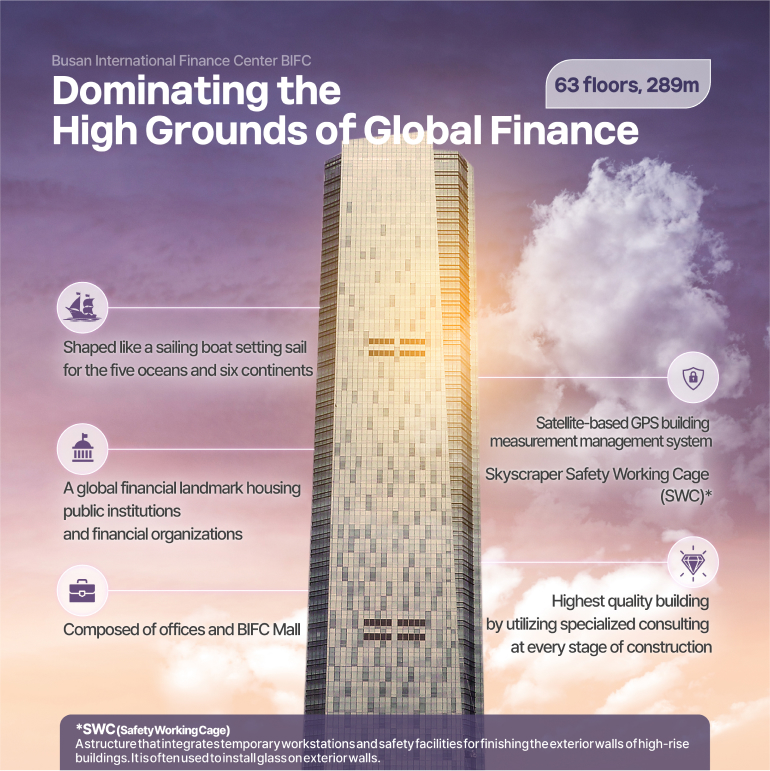
Busan's iconic skyscraper, the 63-story, 289-meter-high Busan International Financial Center, is another remarkable creation by Hyundai E&C. Designed to resemble a sailboat navigating the six major continents across the five oceans, it symbolizes the building's role as a central financial hub in Northeast Asia. Hyundai E&C not only mastered the high-strength concrete technology necessary for such high-rise structures but also ensured top-tier quality through exceptional mixing management. Additionally, a GPS-based building measurement management system was implemented. This system uses satellite-transmitted radio signals to prevent construction accidents and remains unaffected by the building's height or weather conditions. By overcoming the limitations of traditional optical wave systems, which are influenced by measurement distance, angle, and weather conditions, Hyundai E&C’s system enables real-time management of high-rise construction sites with millimeter-level accuracy, even at heights of hundreds of meters.
Like BITEXCO Financial Tower, the Busan International Financial Center also used the outrigger construction method. The two sections of outrigger floors spanning floors 27 to 29 and 47 to 49 were critical to the overall safety of the skyscraper. Hyundai E&C improved the process by prefabricating them at the factory and installing them on site, which not only increased precision and safety, but also helped the project to finish in two weeks less than the expected construction schedule.
The Busan International Financial Center will be home to the Korea Exchange, Korea Securities Depository, Korea Housing Finance Corporation, and other global financial institutions, and will continue to grow as a landmark of the international financial city.
Green Building in Yeouido: The Federation of Korean Industries Building (FKI)
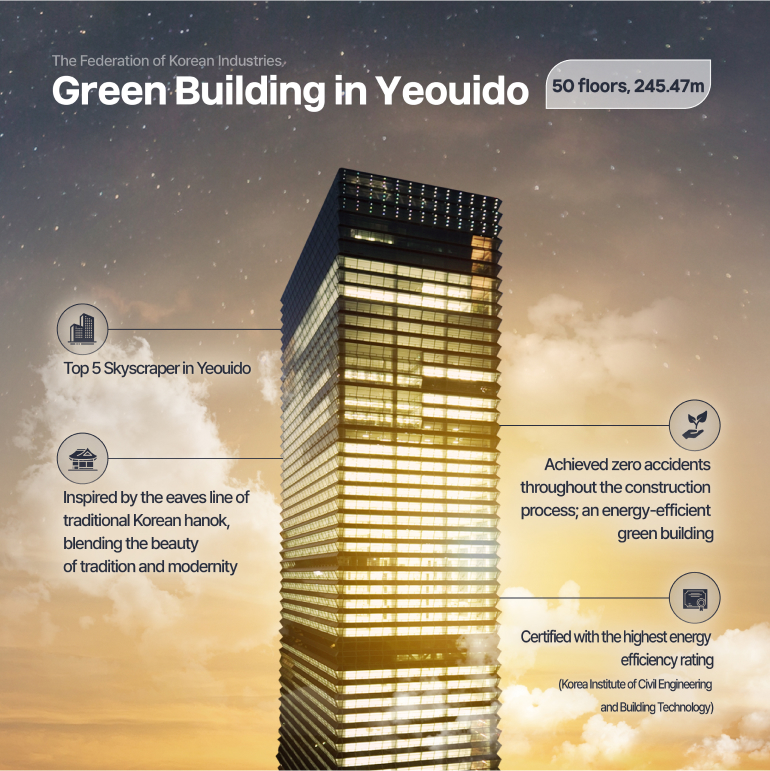
In Yeouido, Korea's financial capital, the new The Federation of Korean Industries building is the third tallest building after Parc1, the International Financial Center, and 63 Building. With a sleek, streamlined exterior inspired by the eaves lines of a hanok or Korean traditional house, the building offers a glimpse of traditional style and modern beauty, but it also holds a green secret. This is because the building, which ranges from 6 floors below ground to 50 floors above ground and is 245.47 meters high, is not only tall but also environmentally sustainable.
First, take a closer look at the building's exterior walls and you'll notice that they're zigzagged instead of smooth and flat. That's because a total of 3,279 solar panels were installed at a 30-degree angle to the sky, incorporating building-integrated photovoltaics (BIPV). The total panel area, 77 percent of the soccer stadium, is said to generate 2,552 KWH of electricity per day, which is responsible for 4 to 7 percent of the venue's electricity usage.* It's safe to say that there is a 50-story solar power plant in Yeouido.
*Source: FKI ESG TOMORROW
In addition to solar panels, the new building boasts high energy efficiency, featuring a gray water system that recycles used water for cleaning, a rainwater recycling system, and a geothermal system that harnesses heat from 150 meters underground for heating and cooling. This efficiency is validated by the Korea Institute of Civil Engineering and Building Technology’s “Energy Efficiency Grade 1 Certification (2013).” Equally impressive is the achievement of zero accidents throughout the entire construction process.
Pioneer of High-Rise Residential Apartment: Hyperion Towers
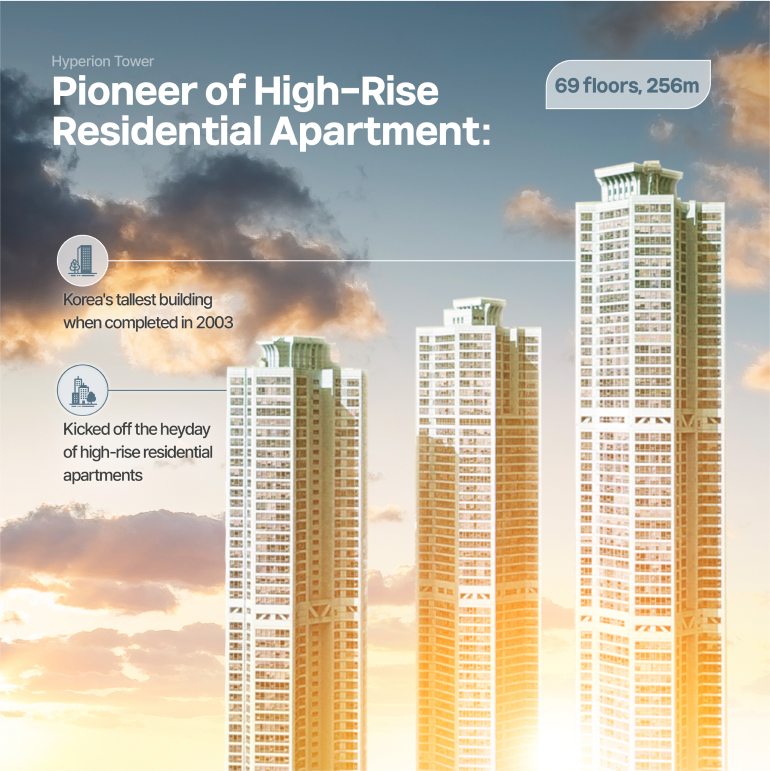
In the 2000s, residential buildings began reaching new heights, with the Mokdong Hyperion Tower standing out as a prime example. Completed in 2003, the tower features 6 basement levels and rises 69 floors to a height of 256 meters, making it the tallest building in Korea at the time, surpassing the 63 Building, and signaling the start of an era of taller residential structures.
As Korea's tallest building at the time, the Hyperion Tower was equipped with advanced earthquake and wind-resistant systems. While typical apartments use concrete with a strength of 20 to 40 MPa, Hyundai E&C applied high-performance concrete with a strength of 50 MPa for this project. Building on this expertise, in 2007, Hyundai E&C introduced ultra-high-performance concrete technology with a strength of 200 MPa—ten times stronger than ordinary concrete—making it possible to construct buildings up to 270 stories high using only reinforced concrete structures.
Recently, Hyundai E&C has also developed a new disaster safety technology, recognized by the Ministry of the Interior and Safety, for its quick-hardening, high-compressive-strength crude steel concrete. This advancement is expected to enable the construction of even taller and safer buildings, showcasing Hyundai E&C's leadership in concrete technology.
Overlooking the Sea from Above: Hillstate Ijin Bay City

Hillstate Ijin Bay City, a super high-rise residential complex in Busan, has become a landmark in Songdo, Busan, with its impressive height of 246.4 meters (spanning from 6 basement floors to 69 floors above ground). Located along Songdo Beach Road, it stands between the sky and the sea, offering breathtaking ocean views from its lofty height.
The building adopted the Outrigger-Beltwall system, which was essential due to the site's direct exposure to strong sea breezes, requiring meticulous planning for wind loads. The beltwall acts as a structural support, providing rigidity when forces are applied to the building, playing a crucial role in constructing a structurally safe skyscraper. A GPS measurement system was also employed to ensure precise construction by minimizing the margin of error.
Notably, Hyundai E&C applied its advanced high-strength concrete technology, utilizing hollow glass powder*, to this building. This innovation is particularly significant for ensuring both workability and safety.
*Hollow Glass Powder-based Functional Concrete: The addition of porous glass powder, a new material, to concrete reduces sticky viscosity, facilitating construction process. In 2022, Hyundai E&C became the first in the world to successfully apply porous glass powder to concrete.
Hyundai E&C’s Excellence in Technology with Artistic Mastery
Super-tall buildings are no longer defined solely by their height. True landmarks emerge when visible aesthetics in design are seamlessly combined with invisible technological excellence. Hyundai E&C's super-tall construction projects exemplify this approach, where advanced technologies converge to create more than just towering structures - they create works of art.
Hyundai E&C is dedicated to pursuing construction that transcends mere height, emphasizing designs that harmonize with the natural environment and incorporating energy-saving technologies that benefit both people and the planet.

